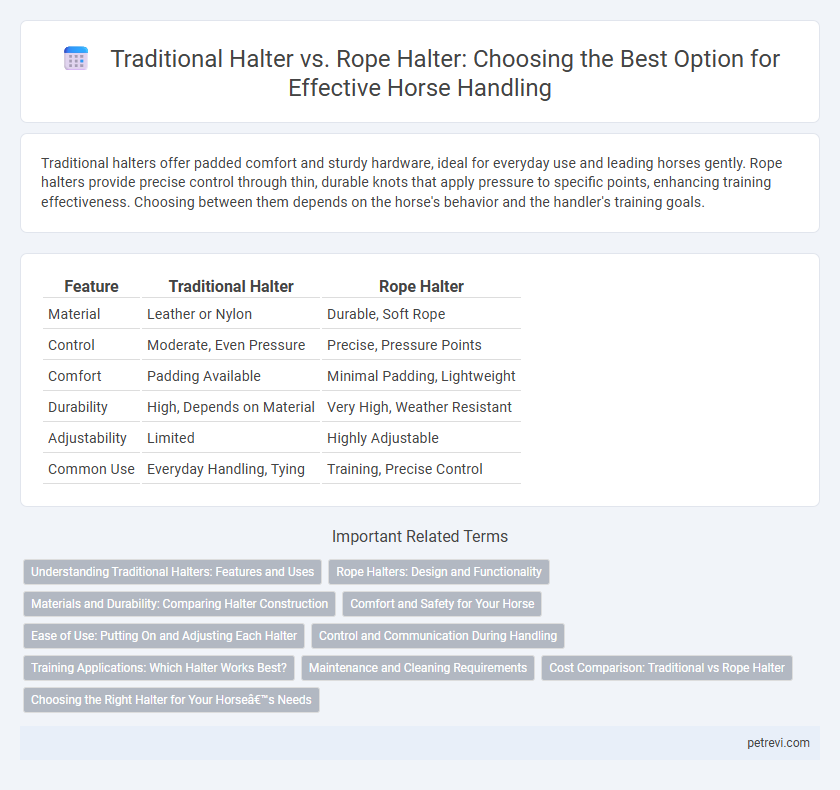Traditional halters offer padded comfort and sturdy hardware, ideal for everyday use and leading horses gently. Rope halters provide precise control through thin, durable knots that apply pressure to specific points, enhancing training effectiveness. Choosing between them depends on the horse's behavior and the handler's training goals.
Table of Comparison
| Feature | Traditional Halter | Rope Halter |
|---|---|---|
| Material | Leather or Nylon | Durable, Soft Rope |
| Control | Moderate, Even Pressure | Precise, Pressure Points |
| Comfort | Padding Available | Minimal Padding, Lightweight |
| Durability | High, Depends on Material | Very High, Weather Resistant |
| Adjustability | Limited | Highly Adjustable |
| Common Use | Everyday Handling, Tying | Training, Precise Control |
Understanding Traditional Halters: Features and Uses
Traditional halters are typically made from materials like leather, nylon, or biothane, offering durability and comfort for everyday horse handling. They usually feature adjustable buckles, a sturdy noseband, and throatlatch, providing secure control during leading, grooming, and tie-ups. These halters are ideal for general use, ensuring safety and ease in handling horses in various settings such as barns, trails, and shows.
Rope Halters: Design and Functionality
Rope halters are crafted from durable, lightweight materials and feature a minimalist design that enhances precise pressure points on a horse's head for effective communication. Their thin, knotted structure allows for subtle cues, promoting better responsiveness and control during handling or training. Unlike traditional halters, rope halters lack metal hardware, reducing weight and minimizing the risk of injury while maintaining strength and durability.
Materials and Durability: Comparing Halter Construction
Traditional halters are commonly made from durable materials like leather or nylon, offering strength and long-lasting wear suitable for everyday use. Rope halters, crafted from high-strength synthetic fibers such as polyester or nylon rope, provide lightweight flexibility while maintaining excellent durability. The tightly braided construction of rope halters enhances resistance to abrasion and weathering, making them ideal for training and active handling scenarios.
Comfort and Safety for Your Horse
Traditional halters, typically made of leather or nylon, offer padded areas that enhance comfort and reduce pressure points on a horse's sensitive face, promoting safety during handling. Rope halters, constructed from lightweight, thin braided material, provide precise control but can create pressure on specific points, potentially causing discomfort if misused. Choosing the right halter depends on balancing comfort with safety needs tailored to your horse's temperament and daily handling routines.
Ease of Use: Putting On and Adjusting Each Halter
Traditional halters typically feature buckles and adjustable straps, making them straightforward to put on and customize for a secure fit on various horse breeds. Rope halters rely on knots and loops, which offer a lightweight design but require skill to adjust properly without causing discomfort or slipping. The ease of use depends on the handler's experience, with traditional halters being more user-friendly for beginners and rope halters preferred by trainers seeking precise control.
Control and Communication During Handling
Traditional halters offer sturdy control through multiple adjustment points and padded nosebands, ensuring comfort while maintaining firm guidance. Rope halters provide precise communication by applying targeted pressure to specific facial nerves, enhancing responsiveness and subtle cue recognition. Effective horse handling benefits from combining the secure fit of traditional halters with the nuanced control inherent in rope halters.
Training Applications: Which Halter Works Best?
Traditional halters, typically made of sturdy nylon or leather, provide solid control ideal for general handling and groundwork but may lack the precision needed for advanced training techniques. Rope halters, crafted from lightweight, knotted rope, offer more precise pressure points that enhance communication and responsiveness during training sessions. For effective horse training, rope halters are often preferred due to their ability to deliver clearer cues, promoting better behavioral adjustments and finer control.
Maintenance and Cleaning Requirements
Traditional halters, made from leather or nylon, require regular cleaning with mild soap and water to prevent dirt buildup and maintain pliability, with leather ones benefiting from conditioning to avoid cracking. Rope halters, typically crafted from durable synthetic fibers, need minimal maintenance but should be rinsed periodically to remove sweat and debris, ensuring longevity and comfort. Proper drying after cleaning is essential for both types to prevent mildew and deterioration, directly impacting the halter's durability and the horse's comfort.
Cost Comparison: Traditional vs Rope Halter
Traditional halters often come with higher price points due to materials like leather or sturdy nylon and hardware such as metal buckles, typically ranging from $20 to $60. Rope halters, favored for minimalist design and lightweight construction, are usually more affordable, with prices between $10 and $30, making them a cost-effective choice for many horse owners. Considering durability and maintenance costs, traditional halters may require more investment over time, while rope halters often offer a balance of low initial cost and ease of upkeep.
Choosing the Right Halter for Your Horse’s Needs
Traditional halters, typically made from leather or nylon, offer durability and comfort for everyday use, making them ideal for general handling and turnout. Rope halters, crafted from lightweight, strong rope with minimal hardware, provide precise control and communication, often favored in training and groundwork. Selecting the right halter hinges on balancing your horse's behavior, intended activity, and comfort preferences to ensure effective handling and safety.
Traditional Halter vs Rope Halter for Horse Handling Infographic

 petrevi.com
petrevi.com